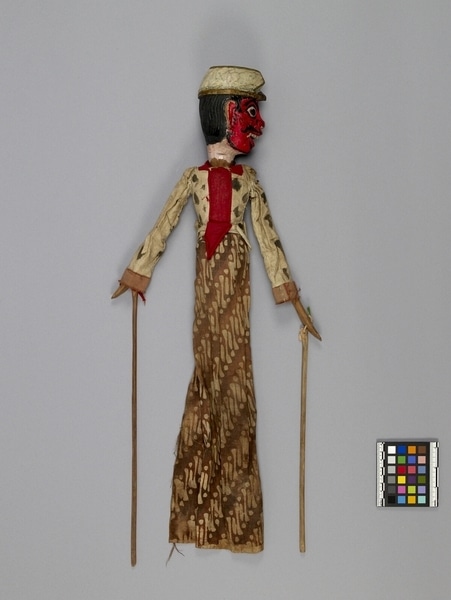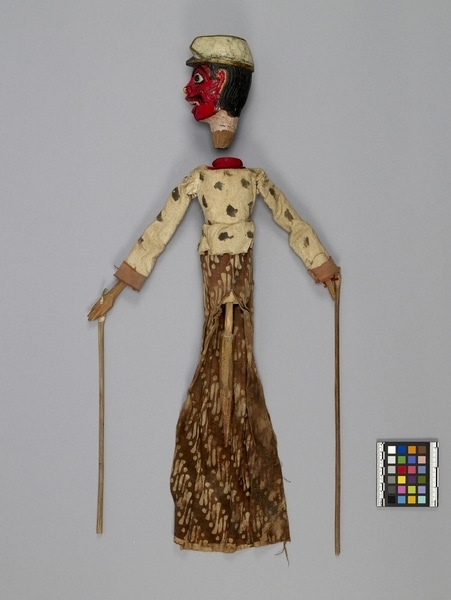Rod Puppet Item Number: Ib296 a-b from the MOA: University of British Columbia


Description
Three-dimensional male humanoid puppet: large head (part b) fits into body clothed in skirt and jacket (part a), and a control rod with a long shaft passes through the body and fits into the neck of the figure's head (currently jammed partially in the torso. The body has jointed arms, each with a long controlling rod attached. The figure has a bright red painted face, and large eyes with white irises and black pupils. Black painted beard, moustache, and eyebrows. Neck painted light pink. Beige cap with black brim. White teeth with downward pointing fang. Black painted hair at rear. Unpainted, elongated hands. Off-white jacket with painted dark grey spots and grey-red cuffs. Red collar and band sewn to chest at front. Long skirt in off-white, light grey, and dark grey batik pattern.
History Of Use
Javanese puppetry as an art form probably developed by the 11th century. The three-dimensional wooden wayang golek puppets of western Java, which are to be distinguished from the earlier and more sacred wayang kulit shadow plays puppets or other forms, appeared during the 16th century. Originally the plays depicted Javanese mythology, but after the Indian conquest of Java the Hindu epics, Ramayana and Mahabharata, were incorporated into the cycles, which comprise about 200 plays. An individual or group hires a dalang (puppet-master) to celebrate important occasions. The performances often last all night and are generally presented in three acts, with vocal and instrumental accompaniment. The individual plays vary widely in detail but usually involve conflict between good and evil. They serve a moral and religious purpose, and more recently, one of political commentary. Each puppet's character is represented by its appearance and placement onstage; protagonists with strong elements of good are placed to the right, antagonists of violent or evil nature to the left. This puppet represents a modern Japanese soldier. The wayang golek puppet theatre was often used by dalangs to spread news or comment on recent events in Java; this was sometimes condoned by the government, who lacked a efficient communications system.
Cultural Context
Theatrical performance.
Iconographic Meaning
Red faces and fangs are characteristic of ogres or demons, indicating fury or other extreme emotions which are considered negative in traditional characters. This puppet, however, represents a modern Japanese soldier circa world war ii. Although its uniform is relatively realistic, its facial features have been distorted to traditional forms and thus evil symbolism has been transposed to a modern figure.
Item History
- Made in Java, Indonesia
- Owned by Tradewind Antiques before March 15, 1983
- Received from Museum of Anthropology Shop Volunteers (Funding source) and Tradewind Antiques (Seller) on March 15, 1983
What
- Name
- Rod Puppet
- Identification Number
- Ib296 a-b
- Type of Item
- puppet
- Material
- wood, cotton fibre, paint and fibre
- Manufacturing Technique
- carved, painted, woven and machine manufactured
- Part B
- height 13.6 cm, width 8.0 cm, depth 8.3 cm
- Part A
- height 55.5 cm, width 10.0 cm, depth 6.5 cm
Who
- Culture
- Sundanese
- Previous Owner
- Tradewind Antiques
- Received from
- Museum of Anthropology Shop Volunteers (Funding source) and Tradewind Antiques (Seller)
Where
- Holding Institution
- MOA: University of British Columbia
- Made in
- Java, Indonesia
When
- Ownership Date
- before March 15, 1983
- Acquisition Date
- on March 15, 1983
Other
- Condition
- fair
- Accession Number
- 0886/0030 a-b